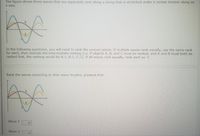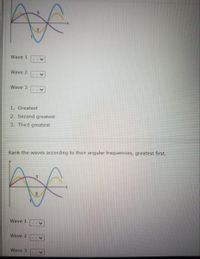Question

Transcribed Image Text:The figure shows three waves that are separately sent along a string that is stretched under a certain tension along an
x axis.
2
In the following questions, you will need to rank the various waves. If multiple waves rank equally, use the same rank
for each, then exclude the intermediate ranking (i.e, if objects A, B, and C must be ranked, and A and B must both be
ranked first, the ranking would be A:1, B:1, C:3). If all waves rank equally, rank each as '1'.
Rank the waves according to their wave lengths, greatest first.
Wave 1
Wave 2

Transcribed Image Text:Wave 1
Wave 2
Wave 3
1. Greatest
2. Second greatest
3. Third greatest
Rank the waves according to their angular frequencies, greatest first.
2
Wave 1
Wave 2
Wave 3
Expert Solution
This question has been solved!
Explore an expertly crafted, step-by-step solution for a thorough understanding of key concepts.
This is a popular solution
Trending nowThis is a popular solution!
Step by stepSolved in 3 steps

Knowledge Booster
Similar questions
- Suppose you shake a slinky continuously in an up and down fashion such that a transverse waves propagate horizontally down its length. If you count 15 peaks have been made during a time of 2.03s, what is the frequency of the wave (in Hz)? V Note: In the space below, please enter you numerical answer. Do not enter any units. If you enter units, your answer will be marked as incorrect.arrow_forwardConstants I Periodic Consider a sine wave traveling down the stretched two- part cord of the figure.(Figure 1) Determine a formula for the ratio of the wavelengths in the two sections. (The frequency is the same in both sections.) Express your answer in terms of the variables µH and uL. ? Ан Submit Request Answer Figure 1 of 1 Part C Light section Heavy section Is the wavelength larger in the heavier cord or the lighter? (a) in the heavier cord Transmitted in the lighter cord pulse Submit Request Answer Reflected pulse (b) Provide Feedback IIarrow_forwardhelparrow_forward
- Problem 1: The figure below shows four identical point sources of sound that are uniformly spaced on an x-axis. Sq d- d S3 d S4 P The sources emit sound at the same wavelength X and same amplitude A, and they emit in phase. A point P is shown on the x axis. Assume that as the sound waves travel to P, the decrease in their amplitude is negligible. What multiple of A is the amplitude of the net wave at P if distance d in the figure is (a) X/4, (b) A/2, and (c) X?arrow_forwardIn the arrangement shown in the figure below, an object of mass m = 4.0 kg hangs from a cord around a light pulley. The length of the cord between point P and the pulley is L = 2.0 m. (Ignore the mass of the vertical section of the cord.) Vibrator- (a) When the vibrator is set to a frequency of 180 Hz, a standing wave with six loops is formed. What must be the linear mass density of the cord? kg/m (b) How many loops (if any) will result if m is changed to 144 kg? (Enter 0 if no loops form.) loops (c) How many loops (if any) will result if m is changed 14 kg? (Enter 0 if no loops form.) loopsarrow_forwardFor any vector quantity, be sure to always include the magnitude and direction tyarrow_forward
- Hello, I understand part a, b, and c. Could you help with parts d and e? Thank you.arrow_forwardPlease download the following worksheets, which show 4 separate grids. Each grid has two different waves (e.g., Wave and Wave B). Your goal is to draw the resulting wave (i.e., Wave C) if the two waves would have been superposed on top of each other. To do this, you'll need to add the two amplitudes (height of the Wave A and Wave B on the y-axis) at a given point on the x-axis to get the resulting one. For example, using number 3 as an example: a. At point 0 on the x axis, Wave A has an amplitude of 0, and Wave B has an amplitude of 0, so Wave C at point 0 would be 0. b. At point 4 on the x axis, Wave A has an amplitude of 6, and Wave B has an amplitude of 4, so Wave C at point 3 would have an amplitude of 10. c. At point 8 on the x axis. Wave A has an amplitdue of 0, and Wave B has an amplitude of -4, so Wave C at point 8 would be -4. You do not have to find the points for every single point along the x-axis, but just enough to get the general shape of the resulting wave. Once you…arrow_forwardWater waves from a source far to the left (not shown) travel in the rightward direction and disturb the height of the water by a maximum displacement A from the equilibrium level (dashed line). Mo the Marmot sits on a boat, which goes up and down as the traveling harmonic water wave passes by. Figure 1 shows a snapshot of this at some time. Figure 2 shows measurements of the vertical displacement from equilibrium, y, of Mo's boat as a function of time, which he recorded with his ioLab device. Figure 1 Figure 2 height [meters] y (meters) wave propagation direction At I (seconds] 2 3 4 -50 -40 -30 -20 -10 10 20 x (meters] What is the speed of the wave propagation? 60 m/s 1.1 m/s 6.7 m/s 42 m/s 260 m/s Which of the following equations best describes the displacement of the water surface from equilibrium, y, at a position a and a time t? y(x, t) = -A cos(kx – wt – 4) y(x, t) = -A cos(kx + wt + 4) %3D O y(x,t) = A cos(kæ + wt)arrow_forward
- The speaker depicted below (See slide 10 of chapter 16 for a detailed explanation) emits a sound of frequency 779 Hz. Due to the path difference (r2 - r1) the receiver detects a constructive interference. Find the distance by which r2 needs to be adjusted to detect the very next destructive interference. (Take speed of sound as 343 m/s).arrow_forward[ Choose ] This is the sixth harmonic This is the fundamental mode of this vibrating object The frequency of this wave is given by v/L There is one node in this standing wave The wavelength of this wave is L/2 The frequency of this wave is given by 3 v/L This is the fifth harmonic The wave length of this wave is 3/2 L There are four nodes in this standing wavearrow_forward
arrow_back_ios
arrow_forward_ios